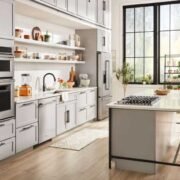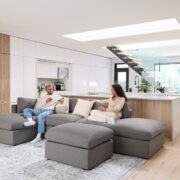Access panels, often overlooked, play a crucial role in interior design and construction projects. They provide easy access to concealed utilities, maintenance areas, and storage rooms, ensuring the functionality and practicality of a space.
This article will examine the significance of access panels in interior design and share valuable insights for seamlessly integrating them into your projects, whether you’re an interior designer or a contractor.
The Significance of Access Panels in Interior Design
Access panels are important, yet often underestimated, elements of interior design and construction. They make it possible to maintain and service the essential components that keep a building running smoothly. Here’s why they are significant:
- Utility Access: Access panels grant easy access to electrical, plumbing, HVAC, and other utilities, making repairs and maintenance hassle-free.
- Maintenance Areas: They allow entry to crawl spaces, attics, and other maintenance zones, ensuring your building stays in top shape.
- Storage Solutions: Access panels can optimize storage solutions by offering hidden compartments for valuables or everyday items.
- Aesthetic and Functional Value: Well-designed access panels blend form and function, adding both style and utility to a space.
Integrating Access Panels into Interior Design
Access panels are not mere functional elements; you can integrate them seamlessly into your interior design. Here’s how to make them part of the whole:
Material and Finish Selection
The choice of materials and finishes for your access panels is crucial for their integration into your interior design. Here’s how to select them thoughtfully:
- Metal: Metals like stainless steel can give access panels a modern, sleek appearance. They are ideal for contemporary spaces and can add an industrial touch to your design. Metal panels are also suitable for high-traffic areas because of their high durability.
- Custom Finishes: Some manufacturers offer custom finishes, allowing you to match the panel’s surface with other elements in the room. Custom finishes can include patterns, textures, or artwork, enabling access panels to blend seamlessly into the overall aesthetic.
Style and Design Integration
Incorporating access panels into your interior design style requires attention to detail. Here’s how to make sure they complement your design theme:
- Minimalist Design: For minimalist and modern interiors, opt for access panels with clean lines and simple, unobtrusive designs. These panels can seamlessly disappear into the wall or ceiling, allowing the focus to remain on other design elements.
- Traditional Spaces: In traditional settings, access panels can mimic architectural details like wainscoting or decorative molding. This approach ensures they become an integral part of the room’s overall character rather than standing out as utilitarian features.
- Eclectic or Bohemian: In more eclectic or bohemian designs, consider using access panels to inject a bit of uniqueness. Custom designs, vibrant colors, or patterns can turn access panels into art pieces, contributing to the room’s eclectic charm.
Case Studies for Inspiration
For inspiration for your projects, it’s essential to study successful examples of how interior designers incorporate access panels into interior projects. Here are some case study ideas:
- Luxury Hotel Suites: Luxury hotels often excel at incorporating access panels discreetly. Look at how they blend access panels into lavish room designs without compromising functionality.
- Historic Renovations: Old buildings and historic renovations frequently require access panels for utilities and maintenance. Discover how architects and designers have seamlessly integrated access panels while preserving the historical charm of the structure.
- Residential Design: Residential projects, such as modern kitchens, bathrooms, and living rooms, provide excellent examples of how access panels can become part of the overall design. Examine how they’ve been used creatively in residential spaces to enhance aesthetics and functionality.
- Commercial Interiors: Restaurants, offices, and retail spaces often face unique design challenges. Explore how highly functional access panels, like the Cendrex DRD draft stop access door, are integrated into these commercial interiors, ensuring a cohesive look and feel.
Proportion and Symmetry: Choosing the Right Size
Selecting the right size for access panels is crucial for maintaining proportion and symmetry in your design. Here’s how to get it right:
- Sizing to Match: Ensure the access panel’s size matches the surrounding elements. It should feel like a natural part of the design.
- Design Styles: Different design styles require different approaches to size. Maintain proportion and symmetry according to the style.
- Harmony With Variety: Work with different sizes and shapes of access panels to create harmony, ensuring they blend seamlessly.
Types of Access Doors
There are various types of access panels to suit specific design and functional needs:
- Standard Panels: The go-to choice for general access needs, available in various materials and sizes.
- Fire-Rated Panels: Ideal for spaces with fire safety requirements, they provide access while ensuring safety.
- Security Panels: Used in areas where added security is crucial, offering access and protection.
- Custom Panels: Tailored to your unique design and functionality requirements, these provide a personalized touch.
Accessibility and Maintenance
Accessibility is key when integrating access panels into your design or construction project. Consider the following:
- Easy Access: Ensure access panels are easily reachable, even if they need to remain discreet.
- Maintenance Planning: Strategically position access panels for easy maintenance without compromising aesthetics.
- Regular Servicing: Include access panels in your maintenance plan to keep them in optimal condition.
Practical Tips From an Interior Design Standpoint
For interior designers, here are some practical tips to make the most of access panels in your projects:
- Plan From the Start: Include access panels in your initial design plans to ensure a seamless fit.
- Avoid Common Pitfalls: Be aware of common mistakes, like neglecting access panel placement or selecting the wrong size.
- Aim for Aesthetic and Functional Balance: Collaborate with builders and contractors to strike the perfect balance between aesthetics and functionality.
Wrapping It Up
Access panels provide access, convenience, and hidden storage solutions in interior design and construction. By considering proportion, style, and accessibility, you can seamlessly integrate access panels into your projects, whether you’re an interior designer creating beautiful spaces or a builder ensuring a well-functioning structure. The art of crafting the perfect interior design begins with these essential elements.
















Comments